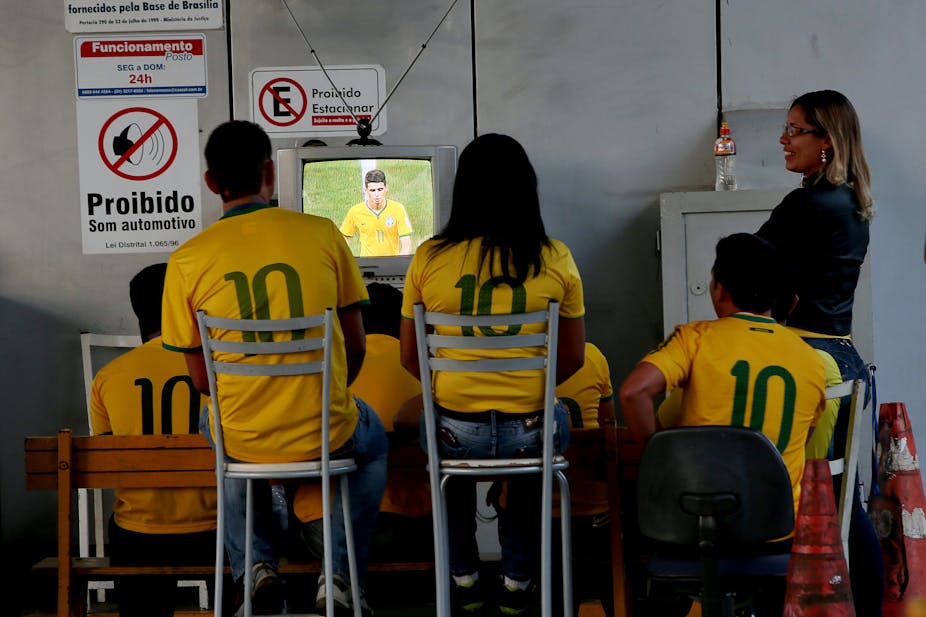Just before a critical World Cup game against Spain in Rio de Janeiro, scores of ticketless Chile fans broke into the expensively rebuilt Maracana Stadium at its least secure point – the media centre.
Surprised sports journalists got a close-up view of the frustrated invaders crashing through the glass doors and flimsy walls of their workspace, but quickly generated pictures and stories of this literally “breaking news” to the outside world.
This incident dramatically contrasts the scarce opportunity of attending the World Cup with the virtual impossibility of avoiding it via the media. About 75,000 people can fit into the Maracana, but FIFA, association football’s world governing authority, estimates that the 2014 World Cup will exceed the 3.2 billion audience reach of the preceding 2010 tournament in South Africa.
In other words, most of us who like football are symbolically compelled to be big-match gatecrashers through the media centre.
The media dominate mega sport events because of the obvious mismatch between stadium access and interest in what happens there. Scale and popularity make them prime-time news in their own right, much to the chagrin of those who couldn’t tell Lionel Messi from a boutique label of Argentinean malbec.
Sport permeates and sustains all media, but it was television that brought it vibrantly live into the lounge room and ensured massive – if incidental – attention to advertising and branding. For this reason, television corporations have been prepared to invest huge sums to secure broadcast rights – US$1.7 billion for Brazil 2014 alone.
Broadcast television is under obvious threat from new media technologies, and it is live sport that has helped keep it alive. Television audiences may be fragmenting, but sport happens in the moment and so demands instant – and lucrative – congregation.
However, singular dependency on a “box in the corner” is long past. Brazil 2014, like the London 2012 Olympics before it, is a multi-screen experience enabled by the transition from analogue to digital media. This has been described as “the first truly digital World Cup” (by app performance company AppDynamics), but it is more convincingly the latest advance in networked media sport, which here draws football, fans, communication and commerce into an ever-more-intimate embrace.
Before the first game kicked off in Sao Paulo, FIFA concluded broadband and mobile rights deals alongside those for television. Therefore, with minimal effort, it is possible for those with the means to watch the action anytime, anywhere.
Giant screens at public viewing sites in cities across the globe, flat-screen pub televisions, office computer monitors, laptops, tablets, smartphones and home stadiums mean that, whether in public or private space, we can always, in some sense, be “at” the World Cup.

But the digital sport world means much more than proliferating options for watching football matches. Social media outlets provide multiple ways for football fans to converse with each other – and for the media, advertisers and sponsors to track the topics that exercise them.
Operations like BBC Trending monitor social media such as Twitter in order to tell the online audience what is running hot on social media and attempt to explain it all. The most noteworthy incident arising from Brazil 2014 so far, though, has not been spectacular goal-scoring by Australia’s Tim Cahill or Colombia’s James Rodriguez, but Uruguayan striker Luis Suarez biting his Italian opponent, Giorgio Chiellini’s shoulder.
Suarez’s snacking on the job created a spectacular Twitter spike, with the term Suarez and hashtag #Suarez used 3.1 million times in a single day (according to BBC Trending). Soon, memes evoking Jaws, Dracula and The Silence of the Lambs were in circulation along with sundry jokes involving blood-stained teeth. These spread in a now-familiar pattern from social media to mainstream reportage of what social media are saying, in turn to be commented on in social media in an ascending regenerative spiral of sport talk.
Suarez may have eliminated England with two goals and followed up with a celebratory dressing-room video post on YouTube, but his scandalous behaviour on the pitch has attracted attention from far beyond the ranks of football followers.

Blanket mainstream media coverage and social media chat have ensured that Suarez’s contribution to World Cup posterity has been with incisor rather than instep. Perhaps it will ultimately define the visual memory of the event itself (like Zinedine Zidane’s headbutt in the final of the Germany 2006 World Cup), sustained by the digital fossil record of slow-motion replays of the bite and the memes that it generated.
In the lead-up to the Brazil World Cup, considerable media attention was paid to local opposition to it on grounds such as financial waste, corruption and oppression of the poor. As is usual with mega sport events, including the Beijing 2008 and Sochi 2014 Olympics, much of this political interest waned once journalists had regular sporting contests to cover.
The Suarez affair has had the effect of breaking the spell, if temporarily. It has taken the focus off the games and onto debates about acceptable and unacceptable conduct among footballers and the world game’s post-colonial structures of discipline and power. Had Brazil been eliminated early, the resultant vacuum might have been filled by renewed protest and media interest in the condition of the country.
Such are the uncertainties when so much professional and citizen media focus is applied to a single high-stakes sport competition in which national pride, sport governance authority and anxious corporate capital are deeply implicated. All the “big” media are there, but they are seemingly as interested in trending patterns among the watchers in cyberspace as in player formations on the field of play.

